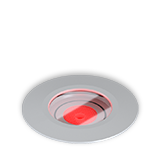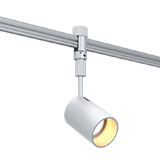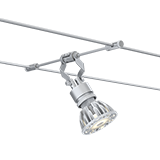Pendant lighting is a luminaire that is composed of one or more light sources suspended from the ceiling by a cord.
LEDs (Light Emitting Diodes) are semiconductor devices, and when an electrical current flows through the LED, it emits light. This technological discovery is a very recent one, dating back to the early 1960s, but it only became popular in the mid-2000s. LEDs rose in popularity due to them being more cost-efficient and lasting more than other types of light in the market.
The average lifespan of an LED light is 50,000 hours.
LED lights work by turning an electrical current into light. When electricity hits the microchip connected to the LED, it creates a chain reaction that leads to the release of photons, or light particles, inside the LED. Non-LED lights convert energy into heat, then heat into light, while LEDs skip the heating step. By turning energy directly into light, LED lights are able to be more efficient, energy-saving, and cost-efficient.
The Colour Rendering Index is a way to measure how faithfully colours are seen in the presence of a light source in comparison to natural light. The CRI scale goes up to 100, this being given to lights that are comparable to daylight. LED lights typically range from 80 to 97 on the index scale.
Lights with a colour temperature of 4500K or higher are considered “daylight” and are the closest to replicating natural light. True daylight has a value of 6500K, so the closer a light is to that temperature, the closer the light source will be to daylight.
When lighting any space, there are three main types of lighting: ambient/general lighting, task lighting, and accent lighting.
Ambient/general lighting: this type of lighting provides light to the entirety of a room independent of other light sources. It’s meant to provide safety and ease of movement in any given room.
Task lighting: this type of lighting is meant to assist in tasks; it’s typically brighter and more focused than ambient lighting, as its intended purpose is to promote productivity.
Accent lighting: this type of lighting is often used to highlight or accentuate a specific spot in a space. By having an added element to focus on, this lighting type adds depth and dimension to rooms. It can be used to illuminate collectibles & collections, art, plants, and architectural features.
There are 4 main types of recessed lighting: in-grade, linear, downlight, and wall-mount luminaires.
Ambient lighting, also called general lighting, is meant to illuminate an entire space without severe shadows to allow ease of movement and provide safety for those passing through. Usually, this is done by using linear luminaires or downlights at an equal distance from each other on the ceiling. Ambient lighting can be seen as a foundation to build upon when it comes to lighting design.
Accent lighting is used to create focal points in a space. It’s used to highlight art, collectibles, or plants and to enhance architectural features. This type of lighting adds depth and creates a more dynamic environment.
Architectural lighting is the combination of aesthetics, function, and efficiency in lighting design. It combines those elements to illuminate an environment while also taking into consideration the architecture itself, the people in the space, and what the space will be used for.
Colour tuning is the ability to adjust the colour temperature of a luminaire. This is a great feature for multi-use spaces that can benefit from a range of different colour temperatures. They’re easily controlled with apps and can have a wide spectrum of temperatures available.
Incandescent lights are one of the oldest lighting technologies, which contain a thin filament wire that heats up when an electric current flows through it. The heated filament then burns brightly and creates light.
Halogen lights are similar to incandescent lights as they also contain a wire filament, but it’s made of tungsten and has halogen gas encased in a secondary chamber. The halogen gas allows the filament to burn at a higher temperature than its predecessor, meaning that halogen lights were able to provide a better light output with less energy consumption.
Light-emitting diodes, also known as LEDs, are very different from incandescent and halogen lights. They don’t contain a wire that needs to be heated up, but microchips in printed circuit boards (PCBs, for short) that produce photons when electricity runs through them. The biggest improvement between LEDs and their predecessors is that LEDs don’t need to create heat to then create light; they skip that step, and any heat that is generated by the lights is minimal.
LED lights generate some heat, but it’s much less than the heat generated by traditional incandescent bulbs. The heat produced by LEDs is absorbed into a heat sink, which helps dissipate it. This allows LED lights to stay cool to the touch, making them safer to use than other types of lighting.
Light colour refers to the colour of light itself. The primary colours are red, blue and green. The combinations of these three colours in different proportions create different light colours that people see.
The calculation of Kelvin for lighting temperature involves measuring the colour temperature of the light source in Kelvins. This is done using a device called a spectrophotometer, which measures the spectral power distribution (SPD) of the light source. The SPD is then compared to a standardized reference source, known as a black body radiator, which emits light at a known temperature. The temperature of the black body radiator that most closely matches the SPD of the light source is then used to determine the colour temperature in Kelvins.
Colour temperature is an important aspect of lighting that affects the mood and atmosphere of a room. It refers to the warmth or coolness of a light source, measured in Kelvin (K). A lower Kelvin value, such as 2700K, is considered “warm” and has a yellowish hue. As the temperature gets higher, the colour of the light starts to shift from candlelight tones to daylight tones; for example, 5000K, is considered “cool” and has a bluish hue.
Colour Correlated Temperature (CCT) is a measure of the colour of light emitted by a light source, measured in degrees Kelvin (K). CCT is a common way to describe the warmth or coolness of a light source. The lower the CCT value, the warmer or more yellow the light appears. The higher the CCT value, the cooler or bluer the light appears.
Colour temperature of a light source decides whether the light emitted is considered warm or cool. Lower colour temperatures mean warm light and give it a yellowish tint. Higher colour temperatures, on the other hand, indicate cool light and give it a blueish tint. Warm light’s colour temperatures range from 2200k to 3000k, whereas they are usually about 4000k for cool light.
Colour Rendering Index (CRI) measures how “real” an object appears in terms of colour when shown under a light. The CRI does not measure the colour of the light, but rather the colour of the object that the light source reveals. Kelvin temperatures, on the other hand, measure the colour temperature, which represents the colour of the light itself.
A luminaire refers to a complete lighting unit, including the light source and the fixture that holds it. Meanwhile, a light fixture is just the part that holds the light bulb.
Landscape lighting is the use of exterior luminaires to illuminate softscape and hardscape features, such as shrubs, trees, ponds and gazebos. Besides creating focus points for the outdoor space, landscape lighting can be used for safety purposes as it provides brightness to walkways, driveways, pathways, patios, decks and other exterior areas with traffic at night.
Photocell, also known as photoelectric cell or censor, is a light sensor that detects light. By being programmed to detect the presence and absence of light, one of the most common applications of photocell is to turn the lights on at dawn and off at sunset. Because of that, photocells automatically adapt to seasonal changes without being affected by daylight-saving time.
Wall washing lighting is the use of vertical and indirect lighting to illuminate the wall. The light source can be installed in the ceiling or floor from a certain distance to the wall, creating a smooth and uniform illumination. With proper execution, wall washing can hide imperfections and roughness of the wall with its smooth “wash” effect.



















